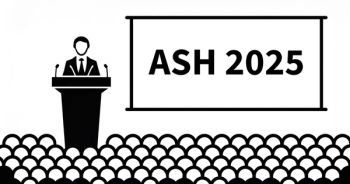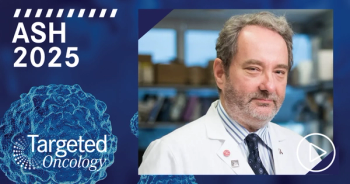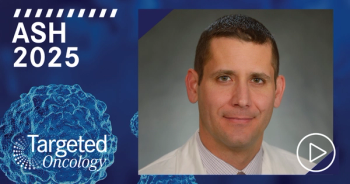
Peers & Perspectives in Oncology
- September I 2025
Bridging and BCMA Exposure Impact Ide-Cel Outcomes in Multiple Myeloma
During a live event, Samuel M. Rubinstein, MD, discussed the outcomes from the KarMMa-3 trial and real-world patients receiving ide-cel in terms of bridging therapy, quality of life, and prior BCMA therapy.
With the increased use of chimeric antigen receptor (CAR) T-cell therapies in multiple myeloma, there is a need to identify which patients benefit most and should have their treatment prioritized. During a
Targeted OncologyTM: What subgroups in the KarMMa-3 trial of idecabtagene vicleucel (ide-cel; Abecma) benefited most receiving CAR T-cell therapy?
Samuel Rubenstein, MD: Triple class–exposed patients who received bridging therapy, which was most of those who were able to successfully get bridged…had a 20.7-month median progression-free survival [PFS], which is significantly better.1 Whether that reflects receiving the bridging improving the PFS, or if this is a subgroup of patients with myeloma who remain responsive to standard agents and is thus lower risk, is unclear. But for what it's worth, if you are successfully able to bridge somebody and get some kind of response, the outlook with CAR T-cell therapy is meaningfully better.
Carfilzomib [Kyprolis] plus dexamethasone, despite being the only doublet, seemed to be the most effective of the bridging therapies used, compared with all those other triplets, which makes sense. This is a largely daratumumab [Darzalex]-refractory population, and the daratumumab-based regimens are the most effective; the remainder are not going to be that effective.
What about change in disease burden during bridging therapy? Those who had decreased disease [burden] obviously get better responses. Soluble BCMA level does decline, which also goes along with having less myeloma, and that may correlate with relatively reduced toxicity burden as well. Those are cancer-specific end points.
Obviously, we want our patients living longer and getting better. So, what happens to the patients who get CAR T in terms of their quality of life? Most of the disease-related symptoms that we see get significantly better after you give somebody CAR T.2 We get a period of a few months after the therapy before those symptoms that worsen due to the disease improve. Some things like emotional and physical functioning are getting better relatively quickly after getting CAR T. It’s an encouraging result that some of the patients who we're treating are not only living longer but are looking better or taking longer [before] progression.
What were the outcomes with ide-cel in a real-world population?
Neurologic toxicity rates in the Center for International Blood and Marrow Transplant Research registry are pretty similar, so the KarMMa-3 trial does reflect a relatively real-world population.3 The probability of deep response is also similar [27% real-world vs 33% in the trial]. In terms of those achieving complete response, factors associated with reduced probability of getting complete response included extramedullary disease, being a high-risk feature in all states of myeloma. [Other factors were] having a low CAR T-cell dose, which goes along with using agents that deplete functional T cells and don't enable adequate manufacturing of CAR T cells, [and] patients with poor performance status. Unfortunately, some of those patients don't live long enough to achieve complete response or don't successfully get bridging therapy. I think that's probably the decisive factor there. Penta-refractory myeloma is more resistant and is less likely to respond well.
How did patients who had prior BCMA-directed therapy respond?
There is a real-world analysis from Christopher Ferreri, MD, who's now at [Atrium Health] Levine Cancer Institute, who was a fellow at [The University of Texas] MD Anderson Cancer Center when he did this.4 There were a small number of patients on this trial and much more in the real world who have had some BCMA-directed therapy prior to undergoing ide-cel treatment. Of course, those who had no prior BCMA-directed therapy are likelier to respond to ide-cel.
If you have had no BCMA-directed therapy, you're more likely to respond than if you do [overall response rate, 88%], but even if you've had a prior BCMA-directed therapy in the real world, your probability of response is still 74%, which outperforms a lot of the other alternatives that we have in the space. Those [who received] prior antibody-drug conjugate, interestingly and counterintuitively, were the least likely to have response, a very small number [68%, n = 37]. Those who had prior CAR T or bispecific…most of those did respond again to ide-cel [100%, n = 5 with prior CAR T; 86%, n = 7 with prior bispecific].
This goes to show that if a patient had 1 prior BCMA directed therapy, they’re not categorically refractory to other BCMA-directed therapies. We're starting to learn more and more about the optimal way to sequence these [therapies]. As more time elapses and we gather more data, this shows that those with no prior BCMA-directed therapy, in addition to having better probability of response, are going to live longer and take longer to progress.
DISCLOSURES: Rubinstein previously reported consulting with Janssen, Sanofi, Roche Diagnostics, and EUSA Pharma.








































